REMEMBERING CHANDRASEGARAN
25 November 1947 to 9 November 2021
This is the story of Chandrasegaran Sangaran Nair, fondly remembered as Chandran, who has left an indelible mark in the hearts of many for the example he led as a pious-hearted believer, and a permanent place in the history of the Bahá’í Faith for the laborious work he had carried out quietly especially at the grassroots level.
Chandran’s introduction to the Faith began with his two elder brothers. In October 1959, his eldest brother Bhaskaran accepted the Faith in Malacca, and that opened the door for his other siblings and finally the parents to accept the Faith in stages. Following Bhaskaran, his younger brother Vasudevan accepted the Faith in August 1960. Through them, Chandran was exposed to the Faith, at a time when he was still a student at the St. David’s High School in Malacca, where Vasudevan too was a teacher. But his two elder brothers did not coerce him or any other siblings into accepting the Faith. Chandran had observed a transformation had taken place in his two brothers. Chandran at that time was attending some other faith gatherings and a few Bahá’í firesides as well. It was at the Bahá’í firesides that Chandran was most impressed by the Bahá’í concept of the unity of mankind. In 1962, his brother Vasudevan invited Chandran to a Bahá’í New Year (Naw-Rúz) party at the Boy Scout Headquarters in Mata Kuching Road, Malacca. There Chandran was touched by the true unity of a rare kind prevalent among the believers coming from different racial backgrounds. At this party, Vasudevan staged a parody of Shakespeare’s Julius Caesar. After the feast, three Bahá’ís – Anthony Fernandez, Raymond Peter, and Tushar Kanti-Paul were called upon to narrate how they became believers. Their stories touched the heart of Chandran, and he signed his Bahá’í declaration soon after.
Chandran served the Faith effectively even as a youth in Malacca. He carried out his first Bahá’í teaching trips in the company of S. K. Somu, who himself had accepted the Faith in 1955. They would visit local rubber plantation settlements called estates to give the Bahá’í teachings. Chandran started to participate in all the conferences and gatherings and had the fondest liking for the Bahá’í Summer Schools held in Malacca where he met elders in the Faith and deepened himself in the Bahá’í teachings. Chandran’s full-fledged services for the Faith ran parallel with his teaching career. Upon completion of his fifth form examinations or General Certificate of Education (G.C.E) “O” level examinations at the end of 1964, Chandran, just 17 years old, started work as a temporary teacher in Bentong town in the state of Pahang through a contact that Bhaskaran provided. And Chandran was the only believer in Bentong town then. Thus his very first posting was to an area completely new to the Faith.
In 1966, Chandran attended teacher training college in Kuantan town in the state of Pahang. At the end of the course, every trainee was given a form, in which they had to mark the state to which they would like to be posted upon graduation. Chandran occupied a home next to the one occupied by T. K. Kannan, himself a home front pioneer from Malacca town to the East Coast (of Peninsular Malaysia) in 1960. Chandran asked Kannan for his advice on where he should go for service. Kannan had said, “If you valued serving the Faith in the East Coast, it would be better for you to mark Pahang as your first place of choice. Just think how much one can do for the Faith, and then decide.” Pahang being a vast territory needed much manpower to develop the Faith in several parts of the state. That advice from Kannan became a turning point in Chandran’s life. Thus, following completion of the teacher training in Kuantan in 1968, this highly spirited young Bahá’í was posted to Bentong town as a teacher from 1968 to 1970. Thereafter too Chandran placed the needs of the Faith in whatever he had to choose his subsequent postings in his teaching career. Throughout his teaching career, Chandran chose to serve in remote and small towns where the Faith had not germinated well, or where much had to be done, especially in the absence of manpower. He had served in Bentong and Jerantut towns in Pahang.
His posting to Bentong was hailed by the Bahá’í national institution as good news. In 1968, Chandran was still the only believer in Bentong. From Bentong, Chandran made frequent visits to Bilut Valley and shared the Faith with the villagers. Stemming from his genuine love for his fellow man, Chandran also gave free English tuition classes to the people of Bilut Valley. By early March 1970 Bahá’í children’s classes were started with Chandran’s efforts. In the same year Chandran became instrumental in forming a Local Bahá’í Youth Committee in Bilut Valley. As Bilut Valley became very receptive to the Faith, members of the National Coordinating Committee, the predecessor to the National Teaching Committee of Malaysia, joyously started making trips to this community. Auxiliary Board Member Mrs. Betty Fernandez, who heard of this booming community, made a trip to this community in 1970. Bilut Valley became a promising area for the Faith, and from the mid-1970s, the Bahá’í community of Petaling Jaya took over the responsibility of developing this community under a plan that was given by the Hand of the Cause of God Dr. Raḥmatu’lláh Muhájir, with friends like Thanabalan, Lum Weng Hoe, Shirley Wong, T. K. Lee and Theenathayalu making trips from time to time. Chandran, happiest to see manpower deployed to Bilut Valley, organised deepening sessions for the local believers and firesides, some even at nearby coffee shops, with tea and snacks thrown in by the jubilant host.
Having created deep impacts in Bentong, Chandran was next posted to teach in Jerantut from 1970 to 1973 where he worked at the government English school. This too was an area where the Faith was still at the nascent stage. At that time there were only three Bahá’ís in Jerantut. They got together and started off some regular Bahá’í activities.
It was in 1973, while Chandran was working in Jerantut that his elder brother Bhaskaran and his wife Sarojini resigned from their government post in Malacca and went pioneering to Cameroon in Africa with their children, thus becoming the first as a family to have left the shores of Malaysia as pioneers. Earlier in May 1967, Bhaskaran’s younger brother Vasudevan was already settled in India as a pioneer. Before leaving for Africa, Bhaskaran took Chandran to a side and said, “It is in you that I put my trust to look after the family, as I am going to Africa.” Chandran, who immediately understood the significance of Bhaskaran’s decision, was happy that he could help him in this way, to leave as a pioneer, and felt very confident that he could guard the trust Bhaskaran had in him. With them having left for pioneering, Chandran took over the helms of looking into the family needs.
Next, Chandran was posted to Segamat town in the state of Johore from 1974 to 1978 and he taught in the Sekolah Kebangsaan Kampong Melayu Raya. This too was a slow moving community, and a cause for concern to the Bahá’í national institutions for several years. Soon Chandran started Bahá’í teaching activities in Segamat. In 1973 one Mr. S. Govindasamy accepted the Faith, along with Mr. Suppiah from the local police department. When sufficient number of adults accepted the Faith, a Local Spiritual Assembly was elected, and that triggered off proper and organised Bahá’í activities in Segamat. Chandran was credited for reshaping the Bahá’í landscape of Segamat during his tenure there.
It was while working in Segamat that Chandran entered into wedlock. Chandran received a message about a marriage proposal, together with the photo of a girl. That was the charming Miss Shoba Nair, who was born in Malaysia, but grew up in Kerala state in India. Her elder brother who was already in Malaysia at the time helped her to resettle in Malaysia in 1974. Chandran, upon wholeheartedly agreeing to the proposal, started to write a series of letters to Shoba, introducing her to the Bahá’í Faith. They married on 8 December 1974. Shoba, who recognized the Cause of Bahá’u’lláh from a deep love for the Bahá’í prayers, accepted the Faith soon after. Chandran taught as a school teacher in Segamat till 1978 and was regularly commuting to Malacca town for a period of time to visit Shoba who was living with his parents then.

Baha’i wedding at the Leong Tat Chee Baha’i Institute, Malacca
In Bentong, Jerantut and Segamat towns where Chandran worked as a school teacher, he exerted all his energy in the development of the Faith. In 1978, he returned to his hometown Jasin, in Malacca state, to work at the Sekolah Rendah Kebangsaan Chin Chin school till 1985. His return to Jasin too was providential for the Faith. He was very sad to see that Jasin had lost its glory of the early days with most of the key believers who held the torch there had left the community on transfer. Jasin was once one of the earliest and leading Bahá’í communities in Malaya since the late 1950s. It was in the surrounding rubber plantation settlements or estates that the Faith had raised high its banners in the late 1950s when mass teaching took place there. The nadir came when he observed that the Lau Leong Estate, Rim Settlement, Serkam Estate, Jasin Lalang Estate, Diamond Jubilee Estate, Devon South Estate, Devon North Estate, and Chubi Estate which boasted of strong believers were no more within the Bahá’í radar. As Chandran observed, a whole generation had dwindled, and lost into oblivion.
Chandran took upon himself the sacred task of reviving the community with all his might, strength and fervour. Mr. Kumara Das and S. K. Somu from Malacca town came to join hands with Chandran to revive these areas. Through Chandran, Mr. Ramasamy, a shopkeeper, Mr. P. G. Kuppusamy, a Tamil school headmaster, and Mr. Maniam from the Telecommunications Department accepted the Faith. With the band of these new believers, Chandran managed within his best to move on with activities. Chandran also focussed on taking the Faith to the estates, in the company of other believers. Chandran organised many gatherings at his residence in Jasin town and in the estates as well.
While in Jasin, and still in his teaching post, Chandran was contemplating pioneering overseas and was pursuing an opportunity in the Seychelles. It was at this time of contemplation that during Ridván 1984 he attended the National Bahá’í Convention of Malaysia in the Ria Hotel in Kuala Lumpur. While seated next to Mr. Baling, head of Iban longhouse of Bukit Ambun in Mukah district, and a delegate to the convention, Chandran enquired about the services he could render to the Faith in the East Malaysian state of Sarawak should he get a transfer there. Mr Baling gave him all the encouragement to go over to Sarawak at the earliest. The seed was firmly planted at that conference and in January 1986, Chandran left for Sarawak with his family. Their son Madhu was ten while their daughter Maya was only four.
Their move to Sarawak was a case of an entire family entering into an unknown, remote, and difficult territory that greeted them with unaccustomed culture and challenging way of life. Chandran started teaching at Sekolah Kebangsaan Kampong Seberang in a remote and isolated village of Mukah as a primary school teacher. After some time, he taught in the Sekolah Kebangsaan Sungei Bedengan, followed by Sekolah Kebangsaan Sungei Penipah, and finally at Sekolah Kebangsaan St. Patrick in Mukah town where he finally retired in 2003. The first contact for them in Mukah through whom they got to understand the community and the local culture well was Mr. Smith Utan, the first believer of Mukah from the Melanau tribe.
Their efforts in Mukah attracted the support of believers from all over Sarawak including Continental Counsellor Dr John Fozdar and his wife Grete in Kuching who became a source of great strength to them. Wherever possible the family served as a team.
Served as a Family
In Mukah, there were no Bahá’í children’s classes as there were hardly any Bahá’í children. The family organised classes which were open to all children, and these classes were usually held on Sundays, after morning prayers, at the Bahá’í Centre in the Melanau village of Kampung Telian Ulu, which was about half an hour drive from town centre where they lived. Madhu and Maya too often travelled with their parents to the more remote Iban longhouses which were about an hour away from Mukah to help with teaching activities, devotional meetings, and children’s classes.
The family also cared for the youth in the community. Majority of the Bahá’í youth in Mukah came from the neighbouring Iban longhouses and were living in the dorms of the two secondary schools in Mukah. They went to the schools in the evenings to hold Bahá’í classes for the students. They also organised activities in public venues such as the City Hall, especially when introducing the Faith to the wider population through exhibitions which often coincided with Bahá’í anniversaries. They would regularly host up to 100 visitors for Naw-Rúz open house celebrations. They also took great pleasure in welcoming and hosting Bahá’í travel teachers from other parts of Sarawak, and also visitors from much further afield, from West Malaysia, and overseas. This family lived a very simple and thrifty life and in many ways they taught the Faith by living the life and not merely by teaching the Faith.
Chandran’s Marks
In Mukah, Chandran was not only involved in building the local Bahá’í community, but also took to charity work, born out of his genuine love for his fellow man. Although Chandran was stationed in Mukah, he travelled regularly and widely across Sarawak and visited many urban communities and rural Iban longhouses and easily won their love and admiration as he became one among them through the genuine love he showed for them. The urban communities he visited and left impressions were, among others, Sibu, Saratok, Miri, Kapit and so many other towns in between. Chandran also regularly represented Mukah at state-wide conferences.
Chandran served in many capacities during his tenure in Sarawak. Chandran and Shoba served on the Local Spiritual Assembly of Mukah district. Chandran himself was appointed to the Regional Teaching Committee of the Central Region and the Area Teaching Committee of Mukah district. He was often elected as a delegate to the State Conventions and was involved actively in its deliberations. He was also appointed as a Huqúqu’lláh representative. He was a quiet trainer himself, developing the talents among the youth who attended his classes. Chandran created a permanent place in the history of the Faith in Sarawak through his restless and arduous services. He was viewed as a soft spoken person, with boundless love for Bahá’u’lláh and his fellow man, believers, and non-believers alike. His many areas of painful sacrifice for the Faith became acutely visible to all those who associated with him. Always radiant and creating a jovial atmosphere was the nature of Chandran. His standup comedy of Alfonso the Flea guaranteed to put a smile on every face at conferences.
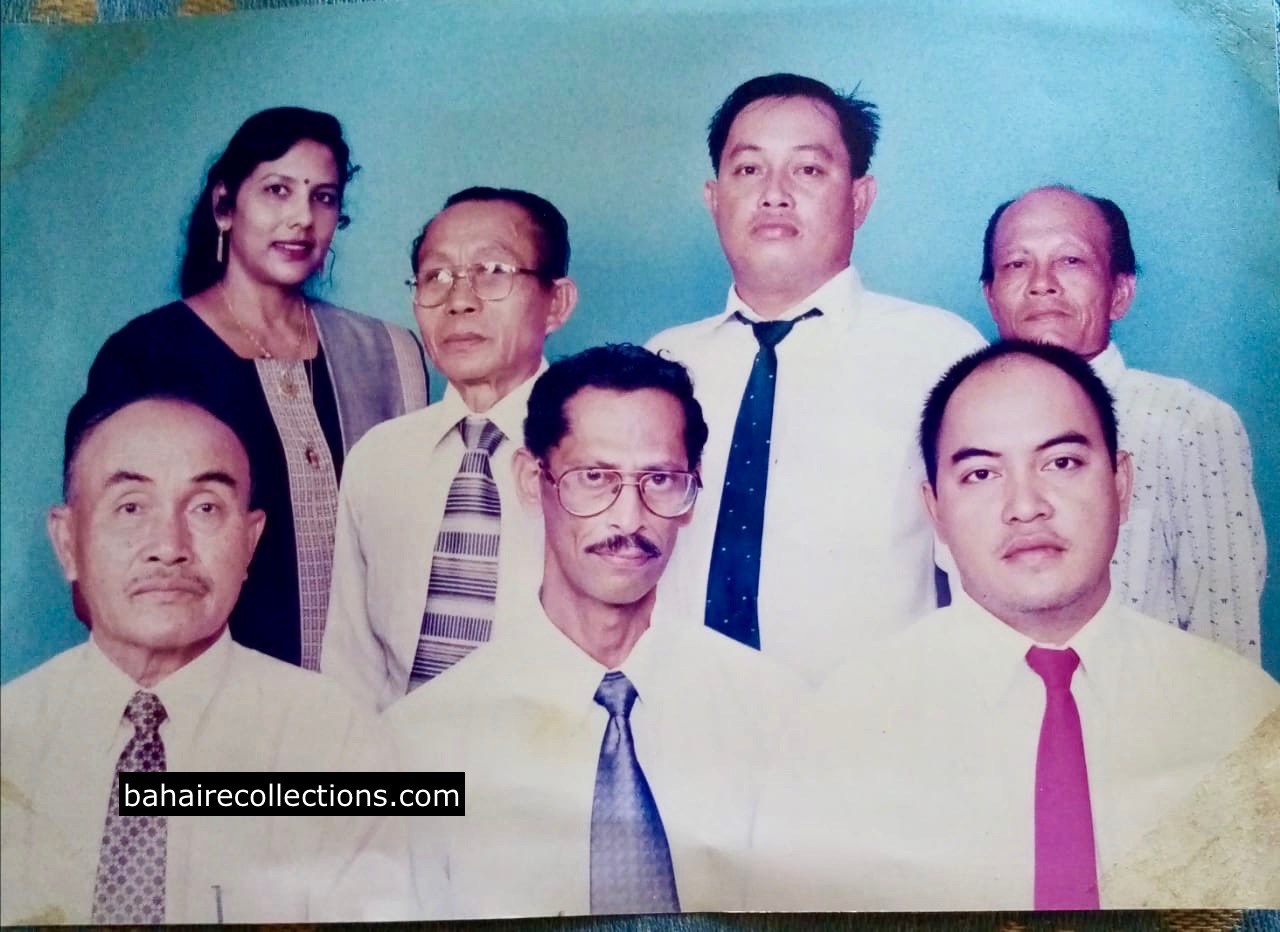
Seven members of the Local Spiritual Assembly of Mukah, Shoba stands at extreme left and Chandran seated in the middle.
The travel teaching trips to visit remote indigenous communities were particularly challenging. Once, when Chandran was spending a holiday in Sibu town, a friend told him about a community that had long not been visited. At that time most of the roads in the rural parts of Sarawak were not properly surfaced and the gravel-covered roads went across hills and sharply declining terrain and around dangerous bends. At one point, on their way to the village, their vehicle crashed into a side ditch to avoid an on-coming truck which had swerved into their lane. Chandran lost consciousness in the accident, and when he awoke, he was miraculously back at home without a scratch on him.

At the Sibu Bahai Centre.
In school, Chandran specialised in teaching English as a second language (TESL) and earned deep appreciation from the parents, teachers, and students for the commitment he had for the profession which was always in the spirit of “Work is Worship; Service is Prayer”. He was a very determined person and was passionate about whatever he had set out to do. Before he was able to acquire a car in Mukah, he had to rely on his motorcycle. He would often rise up before dawn to get in time to the rural schools which were only accessible by river crossings and gravel and earth-covered roads over long distances. He would return home completely exhausted from a whole day’s work and long travel and yet have the determination to continue into the night giving English lessons or hosting Bahá’í activities. In recognition of his commitment to the teaching profession Chandran received several accolades and at the time of his retirement in 2003 the Ministry of Education of Malaysia awarded him the Teachers Excellence Award. Sadly, it was while in Sarawak that Chandran started suffering from epileptic seizures, which first began on his return from a Bahá’í travel teaching trip. That, however, did not deter him from carrying the healing message of Bahá’u’lláh throughout his last breath. By his own admission it was his involvement in Bahá’í activities and regular contemplation on the Holy Writings that he did not suffer much from the debilitating effects of the seizures.
Shoba’s Marks
His better-half and life-long partner, Shoba, was truly supportive of her husband in all his activities, sharing with him the many challenges which came with travelling to remote areas. Being a small coastal town, Mukah was quite isolated from the rest of Sarawak, and the only way out required a three hour journey on gravel-covered roads to the nearest city, Sibu or by flight in a tiny 16-seater Twin Otter. One memorable event in her life in Sarawak was her trip to Sibu town to attend a Bahá’í Women’s Conference. As she flew back to Mukah in the Twin Otter, there was heavy thunderstorm that sent the plane wobbling with the passengers thrown about the cabin, and their heads hitting the cabin roof. She resorted to prayers, and thankfully the plane landed safely at the airport in Mukah. While the runway was clear of water, much of the town centre was heavily flooded. She waded through the water which had risen to her waist level to reach her house braving wild animals displaced by the floods.
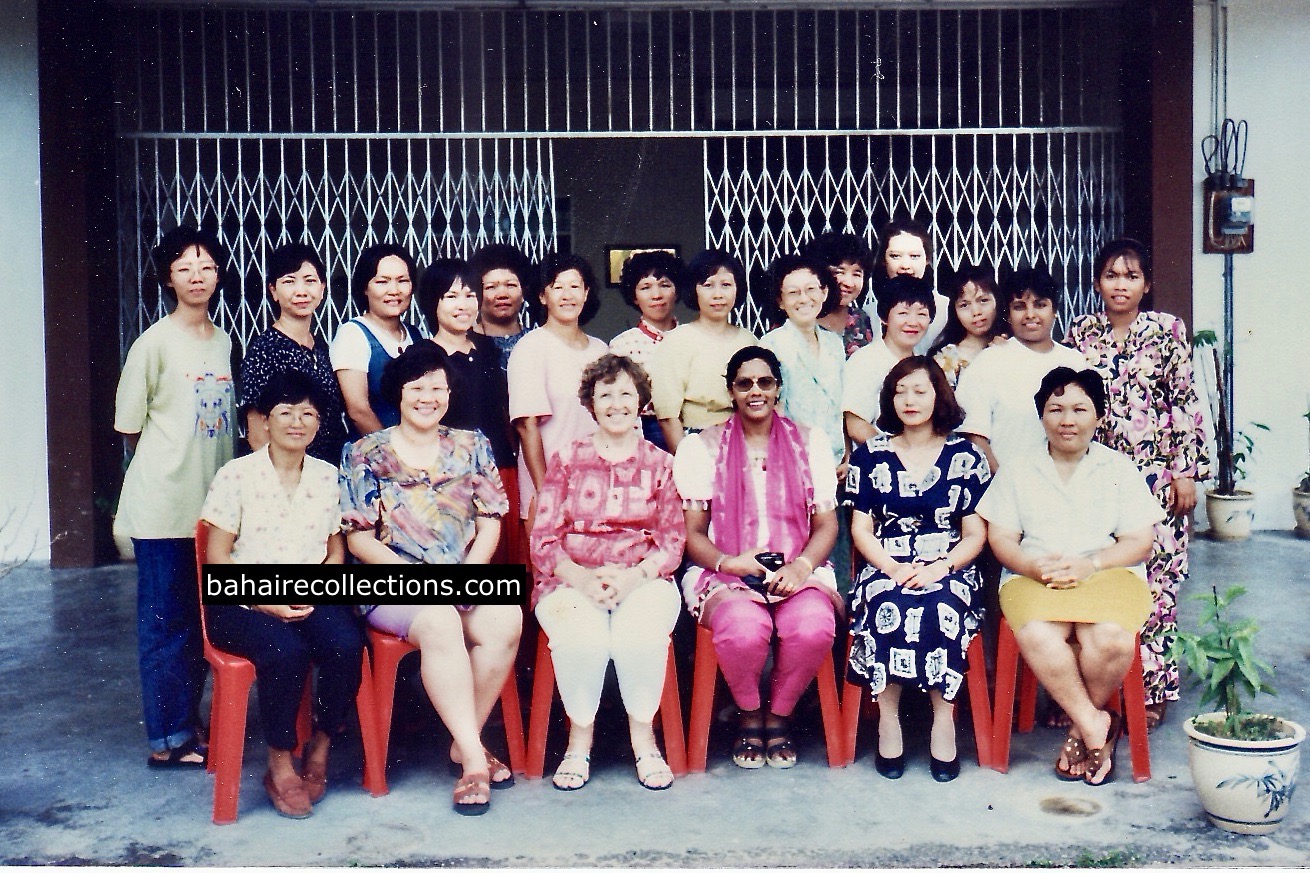
Baha’i women’s Conference in Sibu
Despite such unexpected encounters, her spirit was never diminished, as she knew acutely well that such challenges were part and parcel of life in the pioneering field. Shoba took on several initiatives to build new friendships with women in Mukah. She being an athlete and a Kerala state level volleyball player in her youth, started badminton and basketball training sessions which led to friendly matches with teams from neighbouring districts. She was also well known for her cooking prowess and organised hugely popular Kerala-style cooking classes in the community. She supported socio-economic activities in the Melanau villages and Iban longhouses, and offered one-to-one devotional sessions, especially at times of personal crisis, which spoke to the hearts of the people. All these paid off handsomely by making it possible for her to earn a very wide circle of friends, who were all well informed of the Faith she followed.
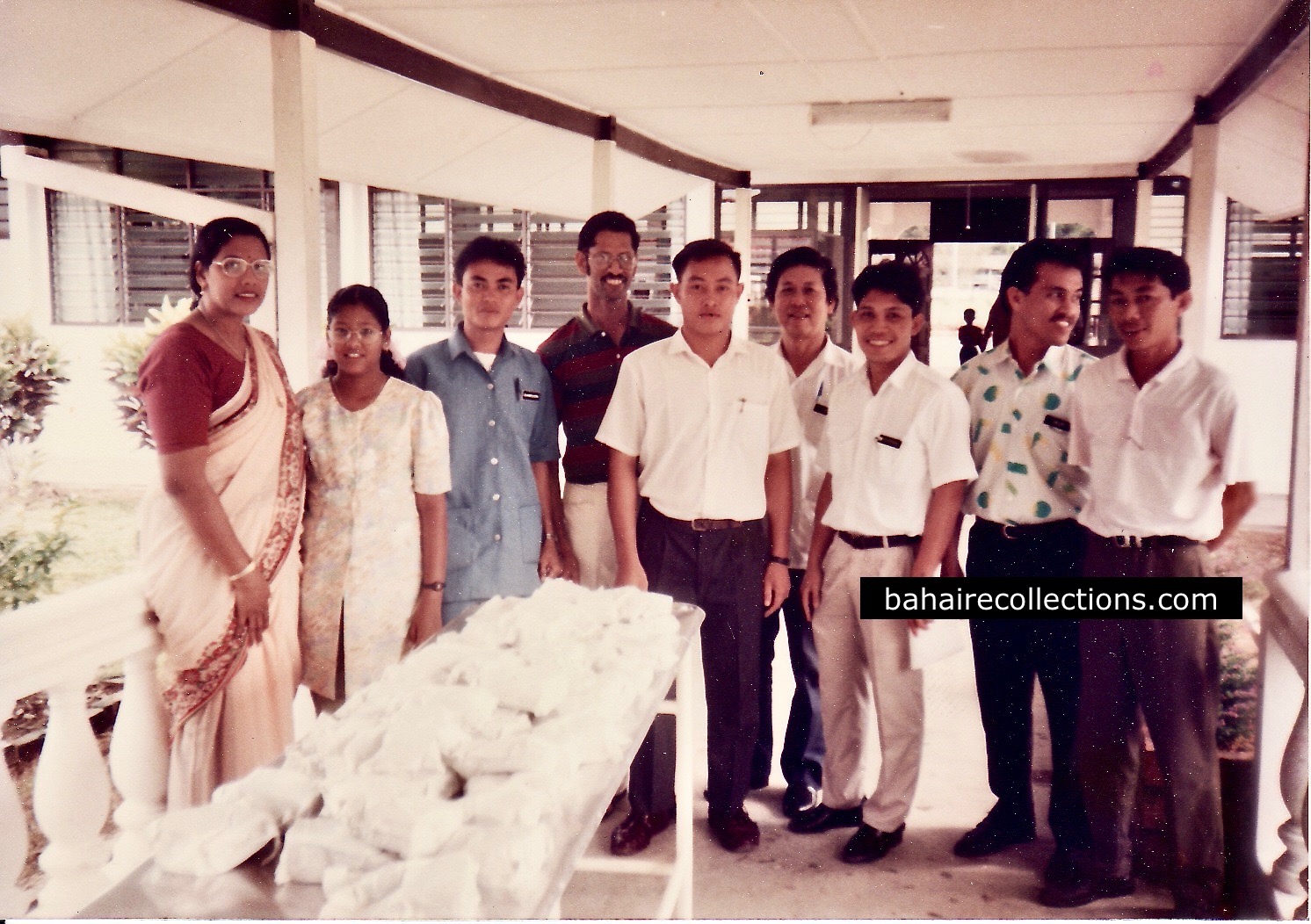
Ayyám-i-Há at the Mukah Hospital. Shoba is at extreme left, with Maya next to her. Chandran is fourth from left.
Outside Mukah, Shoba had undertaken several trips visiting remote communities. In Rumah Kumbong longhouse, situated on the way to Sibu town, the Iban friends slaughtered a pig for their traditional Gawai Dayak festival which is thanksgiving and harvest festival, and Shoba volunteered to cook the meat for them in her Kerala style which they thoroughly enjoyed. There, she also gave a talk on Huqúqu’lláh which had a profound effect on one youth in the audience by the name of Jenau. Jenau, his brother Isang, and one staff nurse Rosita later accompanied Shoba deeper into the jungles to reach a very remote longhouse called Rumah Judi where they stayed for nine days, with Rosita acting as translator. They became firm friends and through the matchmaking effort on the part of Shoba, Jenau and Rosita got married and they live a very happy life together to this day.

Ayyám-i-Há gathering in the Bahai Centre in Kampong Talian

Dr. John Fozdar’s house in a Nine Day Institute. L-R:Chandran, Michael Soo and Suai Anak Kirak
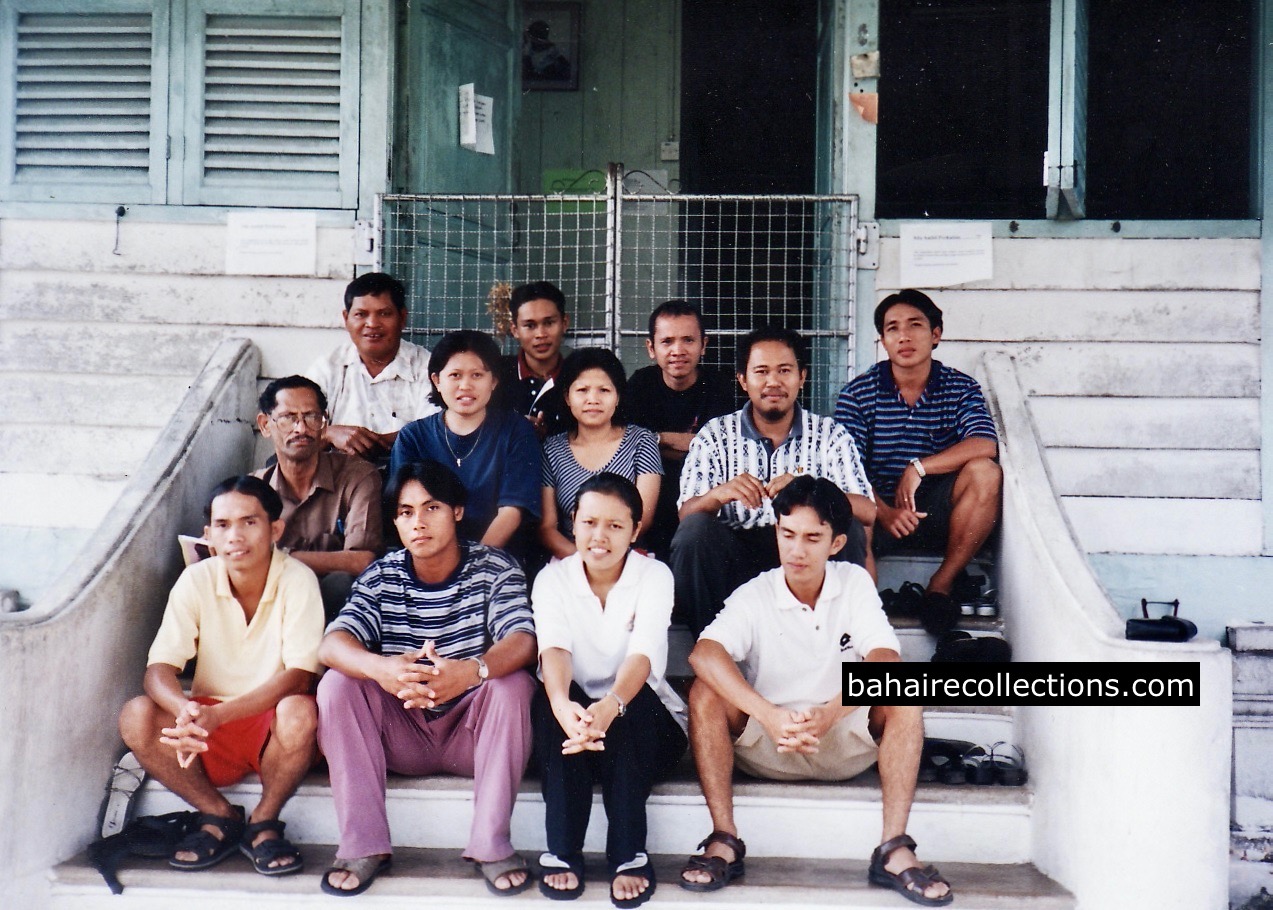
With youths in Kuching town

With Dr. John Fozdar at the Bahá’í Centre.
Children Made Their Marks
Chandran and Shoba made it a point to sit together as a family for meals, prayers, and whenever possible, to travel together for activities. They emphasized on the importance of building resilient character and encouraged their children to excel in everything as one of the ways to gain acceptance especially in new environments. Chandran encouraged global thinking at home, elimination of all forms of prejudice such as by resolving cultural differences, and embraced wholeheartedly the idea of unity in diversity. He also emphasized the importance of punctuality, always finishing what he started, and the value of discipline, order, courtesy, truthfulness and honesty. He would never speak ill of anyone. One of his favourite daily mantras was ‘energy begets energy’ which he would display through his long distance running, tireless grassroots initiatives in the community, and by never sitting idle.
Thus, with such role models, Madhu and Maya too began contributing their part to the pioneering efforts of their parents in their own ways. There were also occasions when they would set off on their own to visit rural indigenous communities outside Mukah town. During a week-long school break, Madhu teamed up with an Iban student from his school as translator to visit several remote Iban longhouses to organise some Bahá’í activities. At one point they got abandoned on a trunk road and resorted to hitchhiking before it became too dark and unsafe for them to be stranded. Fortunately one massive timber truck passing by stopped to pick them up and delivered them safely to the next longhouse on their route!
Madhu and Maya helped Chandran maintain Bahá’í student societies in the two secondary schools in Mukah town. Through these clubs they organised holy day celebrations and other activities on school premises for the benefit of the students. At one time, Madhu also started publishing a local youth newsletter to enhance communication especially with youth in more rural communities. The Bahá’í youth activities were very visible to all students and teachers who passed through the schools.
There are numerous stories of the family having transformed groups of people who were initially hostile towards them. One day such a notorious group of some 12 boys came chasing after Madhu on his way back from school. Madhu, fearing for his own safety, had to barricade himself in his room as the boys followed him back to the house. Instead of admonishing the boys, Chandran and Shoba, who had seen what had happened, invited them over for some cold juice and to play some board games and persuaded Madhu to join them. With just that one gesture of kindness, the boys never bothered them again.
On the eve of their departure from Mukah, they were packing. One mother came running to Shoba to wish her farewell. She remarked how thankful she was to Madhu for changing her son who was always getting into trouble at school, falling into bad company, and getting recruited into violent gangs. Story has it that Madhu had a few run-ins with her son in school as the head pupil and over several challenging encounters they resolved their differences and became friends which completely changed him and helped him make better decisions for himself. When the mother, who herself could not redeem her son, asked the reason for that sudden change in him, the son mentioned his friendship with Madhu.
Maya made her mark by consistently excelling academically in school and for her upright personality and leadership skills. Although she was often a target of school bullies, she was never distracted by them and maintained focus on her studies which eventually earned her the respect of those very same students, who also often came to her for help. As she became fully assimilated into the native Melanau and Iban cultures from a very young age, her familiarity with the local languages was very useful on her visits back to Sarawak during university semester breaks to support various community advancement projects there.
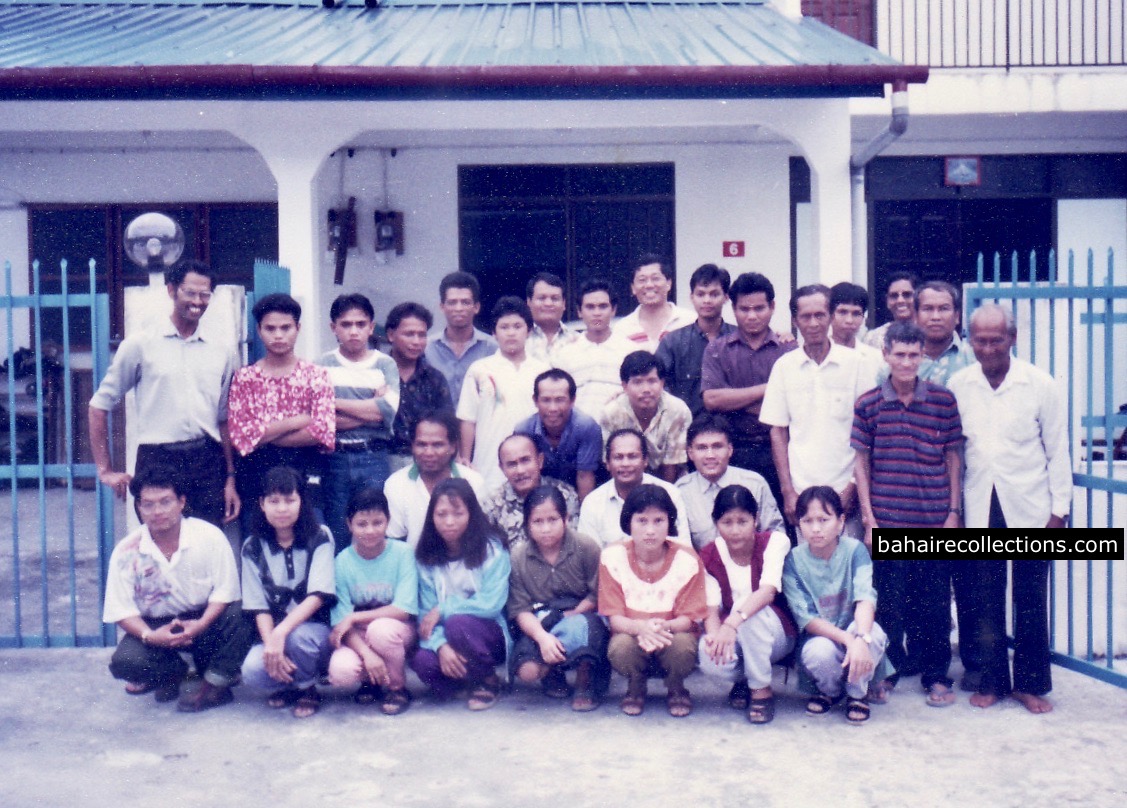
Chandran stands at extreme left, with friends in Mukah
Chandran, though retired in 2003, saw the greater needs of the Faith and decided to stay for one more year in Sarawak to assist furthering the Faith there, especially in the central region of Sarawak. Chandran and Shoba returned to West Malaysia at the end of 2005, to join Maya in Ampang near Kuala Lumpur, after two full decades of dedicated service in Sarawak. In Ampang too, Chandran created indelible marks. While committed to teaching children with special needs in 2012, he enrolled into the College of Allied Educators Malaysia and earned a Diploma in Learning Disorders Management and Child Psychology. Thereafter Chandran continued teaching several children with special needs in the Ampang area.
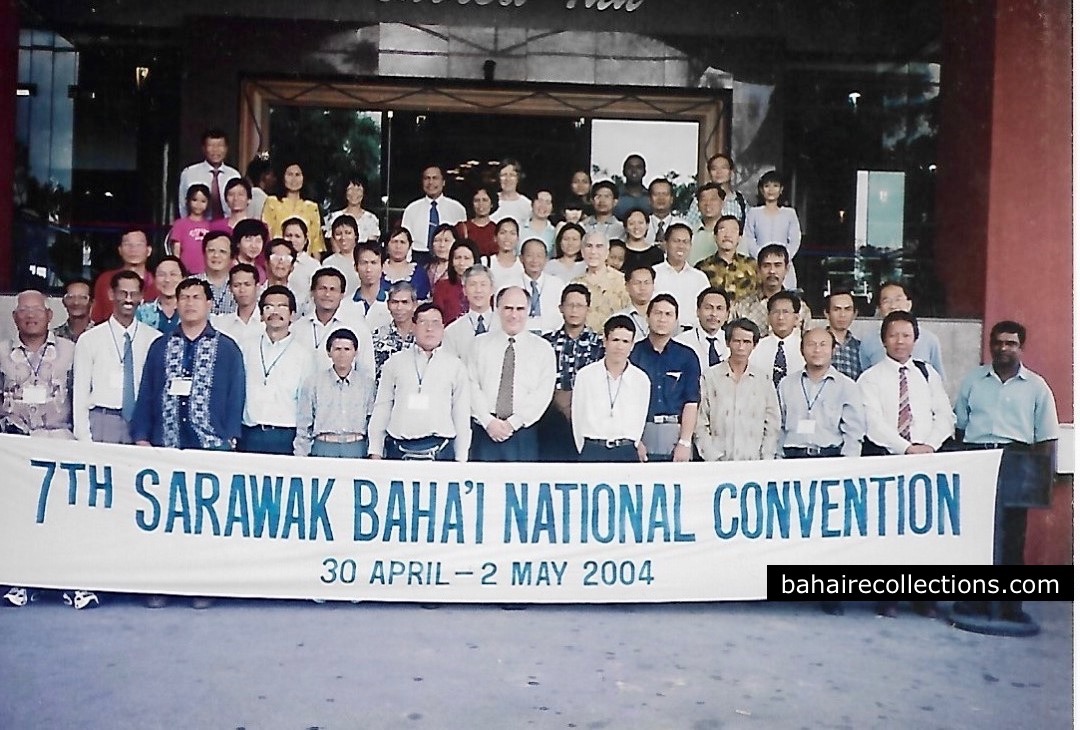
Seventh Sarawak National Convention, 2004. Chandran is second from left on the first row.
All his Bahá’í life Chandran served in small towns or rural areas where he found it more effective to serve the Faith. After returning from Sarawak, he felt that the ever busy city of Kuala Lumpur would not be ideal for his teaching services and chose to go to Kuantan town where he felt he could be more productive.
Merely a few months after moving to Kuantan, he got a job teaching English in an international school in Kemaman. Chandran always had a deep passion for the English language and wrote poetry well. From there he moved over to Teluk Intan town and served for three months in the community while staying with Dr. Sreedharan. But owing to health issues Chandran returned to Ampang. In 2015 Chandran decided to leave Ampang again to serve in Jasin.
All his movement to communities outside Kuala Lumpur was to be effective in teaching in those smaller towns where much manpower was needed. Although his health was not that supportive of his physical movements, he still soldiered on with an undiminished spirit latent within him to serve the Faith. With his health failing further he left Jasin and returned to Ampang permanently in 2018.
While Chandran was in Ampang, his heart was still with Sarawak. He made his last trip there to attend their Bahá’í Veterans Conference held at Damai Beach Resort in Kuching on 10 and 11 September 2018.
On 9 November 2021, in Ampang, Chandran passed away suddenly following major brain surgery at the general hospital while receiving in-patient treatment there.
The exemplary life that Chandran led, with his actions always having spoken louder than his words, will always remain a source of inspiration to those who knew him.
Chandran had always wanted to push himself to the furthest limit in service of the Faith despite his health issues. Throughout his Bahá’í life Chandran wanted to serve with the beloved Guardian’s exhortation as his guiding light: “ The time has come for the friends to think not as to how they should serve the Cause, but how the Cause should be served” (The Priceless Pearl, p. 73).
Although admitted to a Tamil primary school in the Diamond Jubilee Estate in Jasin in 1953, he switched to English primary school in 1954. He still maintained a fairly good command of the Tamil language which was useful in his teaching activities in the estates.
Chandran had adorned himself with the praiseworthy virtues of honesty, sincerity, and humility even from his elementary education days. He earned the admiration from the teachers not only because of his academic performance, but also for outshining other students through his spotless character. Chandran was simply swept into the hearts of students and teachers at school. Chandran never wanted to be a burden to anyone but took pleasure in shouldering the burden of others. Whenever he had visitors to his home he gave the best hospitality, and when travel teachers left his home, he would quietly slip some cash into their pockets.
Chandran, as he would recall often, was fortunate to have been trained and guided by some elders at the time when he accepted the Faith, starting with his brothers Bhaskaran and Vasudevan. Bhaskaran had advised Chandran that in reading any Bahá’í Writings, Chandran was to make sure that he understood the essence of the vocabulary used, and not to merely guess at the dictionary meanings of words. It was with this guidance that Chandran was able to absorb the pulse of the wealth in the Bahá’í Writings. Whenever Chandran told Bhaskaran that he was reading a book, the latter used to enquire whether Chandran had completed the book. Thus, he developed the habit of completing one book, before starting on another.
When Chandran and his wife went to India in 2004, they visited Chandran’s brother Vasudevan in Pune. Vasudevan too advised Chandran along the same lines that Bhaskaran had given. “When reading the Writings, always think out of the box and seek the inner meanings.” This advice helped Chandran a lot especially in not taking the Writings as they appear in print or dictionary.
Another person who Chandran often recalled guiding him in his youth was Auxiliary Board member Mrs. Shantha Sundram from Penang. During a long school break, Chandran, together with 10 to 15 other Bahá’í youth, attended a gathering at her home. At the end of one session, Mrs. Sundram placed a letter box on the table and said “Imagine that this is a letter box through which you can send letters to God. You would have many aspirations in your life. Only if you have your eyes already set upon to achieve a goal, will your life be directed along a certain route. If not, you will go through your days without any particular aspiration. And you will be like the reed that bends any way that the wind blows. And in the end you will achieve nothing. Now, take some time to think carefully of what your goal in life would be. Then, write it down on this slip of paper, and put it into this box. This is a letter you are sending to the Almighty…a private and confidential letter to him. Nobody else will read it,” she said, as she handed out a piece of paper to everyone present. On another occasion, in the course of one of her many talks, Chandran was impressed by a prayer she made a reference to which read: ‘Oh God, make me a hollow reed, from which the pith of self hath been blown so that I may become as a clear channel through which Thy Love may flow to others. I have left behind me impatience and discontent. I will chafe no more at my lot. I commit myself wholly into thy hands, for thou art my Guide in the desert, the Teacher of my ignorance, the Physician of my sickness. I am a soldier in my King’s army. I have given up my will to Him and my life to dispose of as He may please. I know not what fate Thou designest for me, nor will inquire or seek to know. The task of the day suffices for me, all the future is Thine. Thou changest weakness to strength, doubt to faith, perplexity to understanding. When I am fit to bear the burden, Thou wilt lay it on my shoulders. When I am prepared to take the field, Thou wilt assign me a place in the Army of Light. Now I have no other duty than to equip myself for Thy Service. With eagerness and patience, with hope and gratitude, I bend to the task of the hour, lest when Thy call comes I be found unready.’ Over the years, Chandran became particularly drawn to the line ‘…Now I have no other duty than to equip myself for Thy Service. With eagerness and patience, with hope and gratitude, I bend to the task of the hour, lest when Thy call comes I be found unready’, which he endeavoured to practice on a daily basis. Chandran also understood the concept of detachment from a very young age. He would recall how from the age of fifteen, he would go about his work, attending to his filial duties, but at the same time careful not to neglect his duties as a Bahá’í.
One of Chandran’s favourite quotes is this from ‘Abdu’l-Bahá: “If you should thank Him a thousand times with each breath, it would not be sufficient because God has created and trained you. He has protected you from every affliction and prepared every gift and bestowal.” Chandran always felt that under several most difficult situations he had always come out unscathed from the melting pot, all by that promise given by the Master. He would say, “I pray and try to live the Bahá’í way of life, which is the most testing at times.”
In so many ways, the gentle and pure-hearted soul that was Chandran, did and had lived the life!
Comments to the story can be posted to: info@bahairecollections.com
A. Manisegaran
31 January 2022
Copyright@bahairecollections.com
